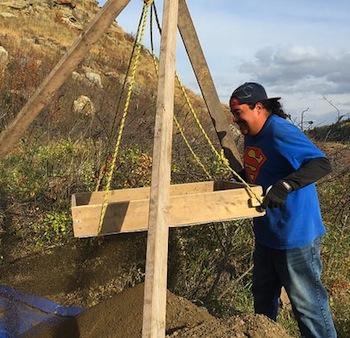Image Caption
By Shari Narine
Sweetgrass Contributing Editor
CALGARY
October 31, 2016.
Artifacts excavated along riverbanks in southern Alberta since the 2013 flood will be sent to the Royal Alberta Museum after they have been cleaned and catalogued.
Darren High Eagle, who has been elbow-deep in on-site work for the past two years, would like to see some of those artifacts – which tell the stories of First Nations people – displayed at the Blackfoot Crossing Historical Park, on his home First Nation of Siksika.
“I get excited when we go to these sites and there’s lot of stuff there to find. We’ve found bison skulls. We’ve found arrow heads. We’ve found buffalo stones,” said High Eagle. “We have a museum on our reserve and it would be nice to see some of the stuff back in there.”
High Eagle is part of the government’s archeological field skills training program for Treaty 7 members, and is one of about 15 to 20 members, who has been learning the meticulous techniques of excavation. Since his graduation from the program in 2015, he has been working with the archaeological consulting company Lifeways of Canada.
Protocol, says Wendy Unfreed, with the Archeological Survey of Alberta, is to have the artifacts go to RAM. But if communities express interest in viewing the artifacts or having community displays, RAM usually works with communities to provide access.
The government will also be receiving a “very large report” from his company Lifeways of Canada, says archeologist Dr. Dan Meyers, with the Calgary lab measuring and cataloguing the artifacts and animal bones. That report will consist not only of details of what was discovered and taken from the sites, but of conclusions drawn on how people lived during those time periods unearthed.
“If any of the communities were interested in hearing what was going on then we’d be willing to present it to them so we could get their perspective on it,” said Unfreed.
While it may have been preferable to have had First Nations involved in the work initially, Unfreed says that the province acted on an “emergency response situation,” moving quickly so as not to lose artifacts and knowledge.
The work was forced because of the damage suffered along the Bow River with large terraces washed away through flooding and subsequent erosion.
“We got a little worried that a lot of those sites may have been taken away,” said Unfreed, noting that river banks are prime territory for archeological sites as people gravitate to water for both living and commerce.
The government hired a number of archeological consultants in 2013 to assess the damage and see what was exposed on the river banks primarily along the systems of the Bow, Highwood and Sheep, and a small portion of the Kananaskis.
About 485 linear kilometres of riverbank were covered in the survey resulting in the discovery of 100 new archeological sites and additional information on 87 existing sites.
“We knew it was going to be a reasonably successful program, but we didn’t know it was going to be this successful,” said Unfreed. “But it’s a mixed feeling because we found a lot of stuff but we only found it at the expense of the fact that it’s been affected by the flood.”
The survey also determined that excavation work needed to be undertaken in about nine sites, which were deemed to be at high risk, said Unfreed.
“We’re trying to get a bit of a nice cross section of history along the river systems,” she said, noting that sites range in age from 6,000 years old to the modern whisky post periods (late 1800s).
One of the more astounding finds – and one Meyers says will probably be a once-in-a-lifetime for him - was a site with two distinct protohistoric layers.
“They’re actually separated by flood events. So that site actually allowed me as an archeologist to look at two different time periods and a protohistoric period is so short – it sounds long but it’s a couple hundred years and in archeological terms that’s very short – but because they’re separated at this site, one has the ability to look at an earlier and a later and therefore within a protohistoric time period look at change within that time period,” he said.
This finding, says Meyers, identifies how rapid the change was within the protohistoric time period.
“The transition from some of the traditional technologies, such as the use of stone tools to metals, seems to have occurred relatively quickly. And I think the view point that a lot of archeologists would have had beforehand is that it was a slow transition,” he said. That determination had been based on comparing a protohistoric site to a pre-contact site.

